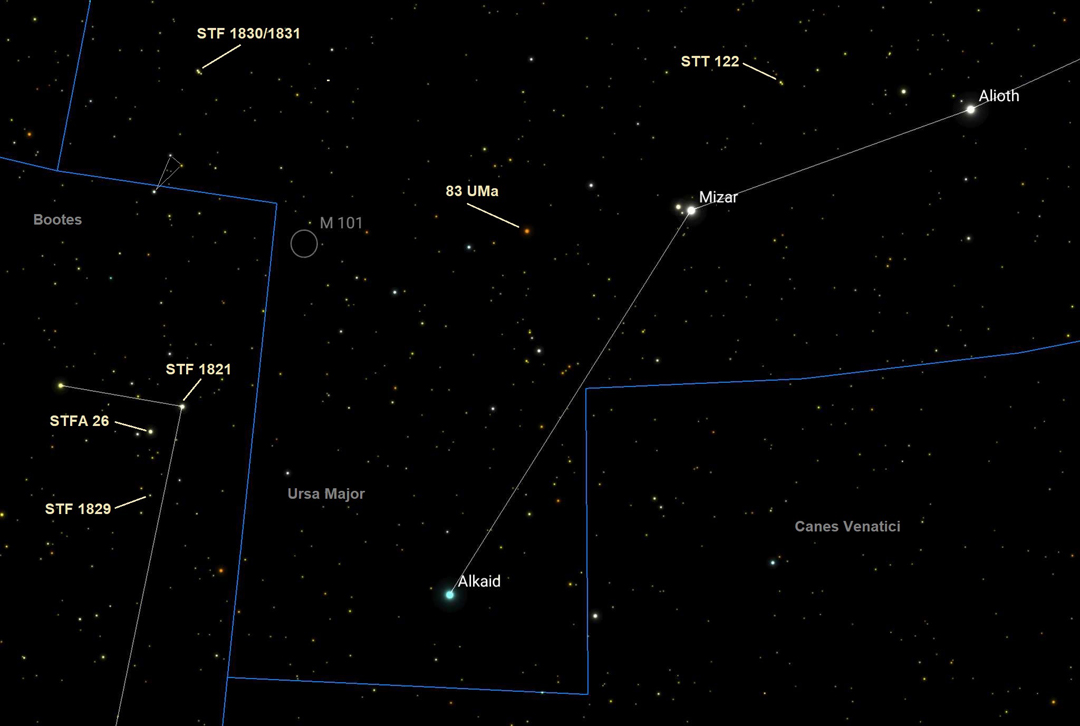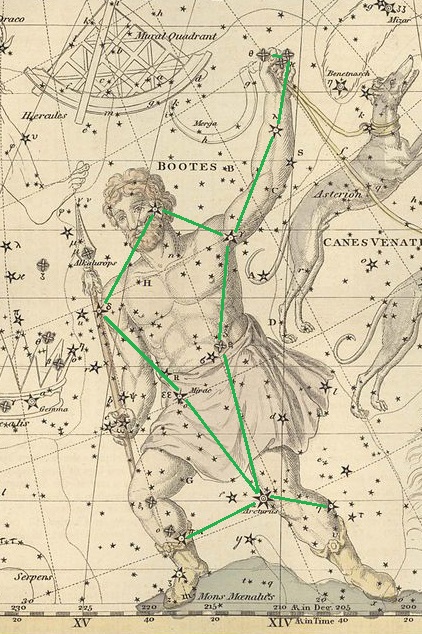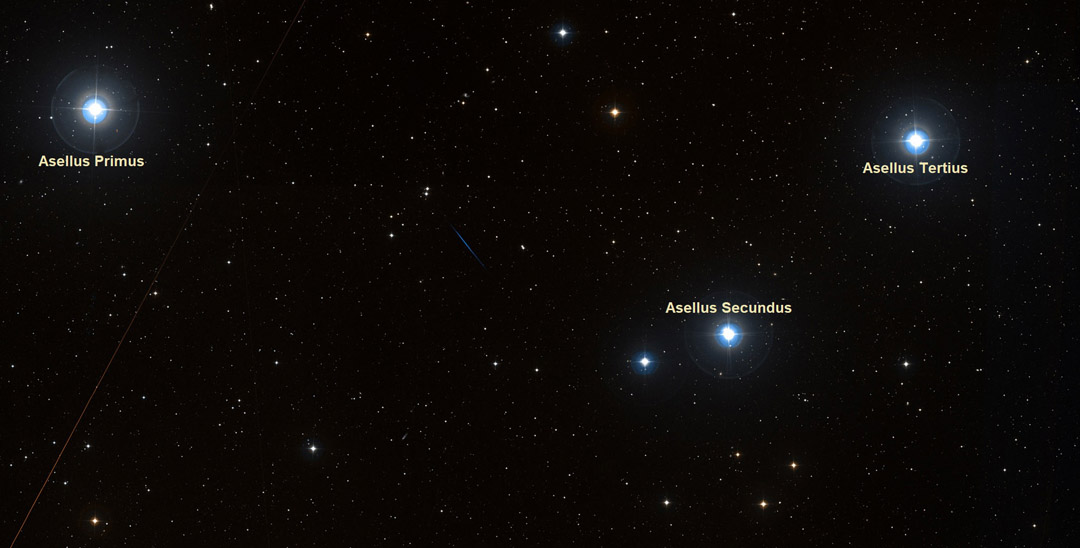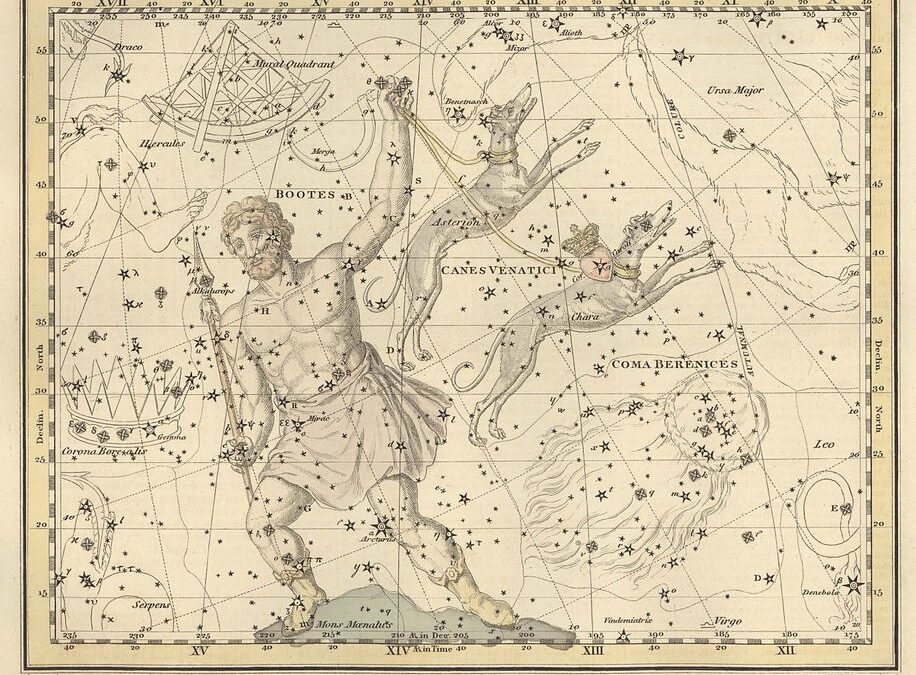Following up on a conversation about SHY double stars in the Cloudy Nights binocular forum, I decided to observe the double star STTA 122, which includes the “E” component of SHY 247, a comoving stellar companion to what is arguably the most famous of all double stars — Mizar in Ursa Major. (The above celestial atlas chart including the constellation Boötes is Plate 7 from the Celestial Atlas of Alexander Jamieson, published in 1822. Image source: Wikimedia Commons.) And I did exercise self-restraint with the post title. It could have been worse. 😉

The above chart created in Sky Safari includes annotations for the double stars described in this post.
STTA 122
13h13m +56*43′
AB 6.88/8.11 sep 126″ pa 216*
Non-physical / optical
Distance: 82.5 LY / 2100 LY
Spectral Type: G1Va, main-sequence / G5
Color Index: +0.60 yellow / +1.19 orange
Luminosity: 1.01 suns visual / 224 suns visual
Size: 1.01 sun diameters / ??
82XL-SD+14XWs: White primary with a sand colored secondary. Generously spaced. I can see TYC 3846-0687-1 near the secondary (10.42 magnitude), holding it steadily in view. With a 59.3% illuminated moon and somewhat hazy skies. The STTA 122 double is also easily seen with the mounted Maven b.5 10×56.
Part of the fun of this observation is knowing that the secondary star of STTA 122 is more then 2000 light years away from the primary. It’s a line of sight pairing not a physically related binary star. But the star Mizar, 2*17′ to the south east, totally unrelated by all appearance, is in reality quite near to it and physically associated with the STTA 122 primary star.
Next up is a pair of double stars, STF 1831 and 1830, about eight and a half degrees to the east, but while enroute I paused to enjoy the M2III giant star 83 UMa. It is distinctly orange (color index +1.63 orange-red), 520 light years distant with a visual luminosity 307x that of our own sun (total luminosity 1280x our sun’s because much of its energy is in infrared wavelengths). Its diameter is 95x that of our sun.
STF 1831
14h16m +56*43′
AC 7.16/6.73 sep 112.2″ pa 219*
Physical double star.
82XL-SD+14XWs: Gloss white primary with blue white secondary, widely spaced. Easily seen with the Maven 10×56 as well.
STF 1830
14h16m +56*43′
EF 9.23/9.98 sep 10.6″ pa 312*
Optical double star.
82XL-SD+14XWs: I can just resolve this double, which is southwest of the 1831 primary. Clearly separated. The secondary is faint in the moonlit sky. Nevertheless, a fine view. I can see 1830 as a star with the Maven b.5 10×56, but cannot resolve the components.
A trio of 6th magnitude stars forms a triangular asterism (annotated with thin gray lines in the Sky Safari chart) pointing to the south and crossing the border between Ursa Major and Boötes. It is easily seen in binoculars and a helpful navigation aid to establish the position of the IAU constellation boundary. It points toward Asellus Primus, which forms a trio of brilliant 4th magnitude stars, depicted in the Jaimeson celestial atlas as the upraised left fist of Boötes holding the leads of the hunting dogs (Canes Venatici).

Johann Bayer named the three stars Asellus Primus, Secondus, and Tertius (first, second and third donkey) in his celestial atlas the Uranometria, published in 1603. No one seems to know why.

I wandered down to the Asellian region with the 82XL and was delighted to find that both Asellus Tertius and Secondus are fantastic binocular double stars in a gorgeous star field. Bounty indeed. For the record, Asellus Primus is also a double star, but the 11.46 magnitude companion is much too faint to be seen with most binoculars from a suburban location. It might be possible to view with something like the Oberwerk 127XL or with an instrument not quite so large from a darker site.
STF 1821 / 17 Boo / Kappa2 / Asellus Tertius
14h13m +5147′
4.53/6.62 sep 13.8″ pa 235
Physical double star.
Distance: 161.84 LY / 153.86 LY
Spectral Type: A7IV / F2V C
Color Index: +0.21 yellow-white / +0.39 yellow-white
82XL-SD+14XWs: Fantastic! Brilliant white stars, the primary much brighter. Close but not tight. The highlight of my observing session. AND in the same field with STFA 26, which is 21 Bootis.
STFA 26 / Asellus Secondus
14h16m +51*22′
4.76/7.39 sep 39″ pa 33*
Physical double star
Distance: 96.25 / 95.84
Spectral Type: A7V C / K1V C
Color Index: +0.22 yellow-white / +0.83 yellow-orange
Warm white primary with tan secondary. Cozy but not close. In a gorgeous field.
And just under one degree to the south, yet another fine binocular double star in this remarkable star field.
STF 1829
14h15m +50*26′
8.10/8.63 sep 5.6″ pa 151*
Physical double star
Distance: 481.22 LY / 479.69 LY
Spectral Type: F5
Color Index: +0.43 yellow-white
82XL-SD+14XWs: Tight but separated by a hair. In a triangular asterism. Primary brighter than secondary. A striking 32x double and bound to be a favorite of a Cloudy Nights friend who relishes observing doubles like this with an APM 34×80 binocular.
These three double stars are only a start on the binary bounty Boötes has to offer for binocular observers viewing from light polluted skies. StelleDoppie lists 27 doubles with primary and secondary magnitudes greater than 9 and separations between 5 and 400 arc-seconds.


Awesome!!
I’m gonna give these a go tonight with the p-gram mounted 15x70D. A few look pretty close for the Deluxe tho, so I’ll have an AT70ED with Baader zoom on standby just in case… I know it’s not a bino or BT, but for now I’ll just pretend it’s half of a 70XL-ED 😆
Hopefully doubles with the binos and small scope won’t be quiet as affected by the wildfire smoke as my AD8 was last night. SQM readings over 21mpsas yet I could just barely make out M101 when checking out SN 2023ixf in the 8″ Dob, and I’m all the way down in mountains of NC!!
It was really bad here too last night, Astro. I could barely see Alphecca. 😂 My first thought was why are you even out here, Fiske?? But then I did find some things and had a good time. Report to follow. 😉